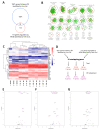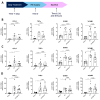Inhibition of BRD4 Reduces Neutrophil Activation and Adhesion to the Vascular Endothelium Following Ischemia Reperfusion Injury
- PMID: 33348732
- PMCID: PMC7767067
- DOI: 10.3390/ijms21249620
Inhibition of BRD4 Reduces Neutrophil Activation and Adhesion to the Vascular Endothelium Following Ischemia Reperfusion Injury
Abstract
Renal ischemia reperfusion injury (IRI) is associated with inflammation, including neutrophil infiltration that exacerbates the initial ischemic insult. The molecular pathways involved are poorly characterized and there is currently no treatment. We performed an in silico analysis demonstrating changes in NFκB-mediated gene expression in early renal IRI. We then evaluated NFκB-blockade with a BRD4 inhibitor on neutrophil adhesion to endothelial cells in vitro, and tested BRD4 inhibition in an in vivo IRI model. BRD4 inhibition attenuated neutrophil adhesion to activated endothelial cells. In vivo, IRI led to increased expression of cytokines and adhesion molecules at 6 h post-IRI with sustained up-regulated expression to 48 h post-IRI. These effects were attenuated, in part, with BRD4 inhibition. Absolute neutrophil counts increased significantly in the bone marrow, blood, and kidney 24 h post-IRI. Activated neutrophils increased in the blood and kidney at 6 h post-IRI and remained elevated in the kidney until 48 h post-IRI. BRD4 inhibition reduced both total and activated neutrophil counts in the kidney. IRI-induced tubular injury correlated with neutrophil accumulation and was reduced by BRD4 inhibition. In summary, BRD4 inhibition has important systemic and renal effects on neutrophils, and these effects are associated with reduced renal injury.
Keywords: BRD4; NFκB; inflammation; ischemia-reperfusion; neutrophils; tubule injury.
Conflict of interest statement
The authors declare no conflict of interest
Figures












Similar articles
-
Inhibition of BRD4 alleviates pyroptosis induced by testicular ischemia/reperfusion injury through the NLRP3 pathway.Tissue Cell. 2025 Aug;95:102919. doi: 10.1016/j.tice.2025.102919. Epub 2025 Apr 15. Tissue Cell. 2025. PMID: 40262486
-
Inhibition of Brd4 alleviates renal ischemia/reperfusion injury-induced apoptosis and endoplasmic reticulum stress by blocking FoxO4-mediated oxidative stress.Redox Biol. 2019 Jun;24:101195. doi: 10.1016/j.redox.2019.101195. Epub 2019 Apr 11. Redox Biol. 2019. PMID: 31004990 Free PMC article.
-
Endogenous IL-33 Contributes to Kidney Ischemia-Reperfusion Injury as an Alarmin.J Am Soc Nephrol. 2018 Apr;29(4):1272-1288. doi: 10.1681/ASN.2017060650. Epub 2018 Feb 7. J Am Soc Nephrol. 2018. PMID: 29436517 Free PMC article.
-
Neutrophils: a cornerstone of liver ischemia and reperfusion injury.Lab Invest. 2018 Jan;98(1):51-62. doi: 10.1038/labinvest.2017.90. Epub 2017 Sep 18. Lab Invest. 2018. PMID: 28920945 Review.
-
Tissue Dependent Role of PTX3 During Ischemia-Reperfusion Injury.Front Immunol. 2019 Jul 10;10:1461. doi: 10.3389/fimmu.2019.01461. eCollection 2019. Front Immunol. 2019. PMID: 31354697 Free PMC article. Review.
Cited by
-
Recent Approaches to Targeting Canonical NFκB Signaling in the Early Inflammatory Response to Renal IRI.J Am Soc Nephrol. 2021 Sep;32(9):2117-2124. doi: 10.1681/ASN.2021010069. Epub 2021 Jun 9. J Am Soc Nephrol. 2021. PMID: 34108233 Free PMC article. Review.
-
Development and Validation of Robust Ferroptosis-Related Genes in Myocardial Ischemia-Reperfusion Injury.J Cardiovasc Dev Dis. 2023 Aug 12;10(8):344. doi: 10.3390/jcdd10080344. J Cardiovasc Dev Dis. 2023. PMID: 37623357 Free PMC article.
-
LINC00161 upregulated by M2-like tumor-associated macrophages promotes hepatocellular carcinoma progression by methylating HACE1 promoters.Cytotechnology. 2024 Dec;76(6):777-793. doi: 10.1007/s10616-024-00653-y. Epub 2024 Aug 16. Cytotechnology. 2024. PMID: 39435425
-
Complement-Mediated Two-Step NETosis: Serum-Induced Complement Activation and Calcium Influx Generate NADPH Oxidase-Dependent NETs in Serum-Free Conditions.Int J Mol Sci. 2024 Sep 5;25(17):9625. doi: 10.3390/ijms25179625. Int J Mol Sci. 2024. PMID: 39273570 Free PMC article.
-
The effect of JQ1 systemic administration on oxidative stress and apoptotic markers in renal ischemic reperfusion injury in a rat model.J Med Life. 2023 May;16(5):682-688. doi: 10.25122/jml-2022-0287. J Med Life. 2023. PMID: 37520478 Free PMC article.
References
-
- Ding Z.-M., Babensee J.E., Simon S.I., Lu H., Perrard J.L., Bullard D.C., Dai X.Y., Bromley S.K., Dustin M.L., Entman M.L. Relative contribution of LFA-1 and Mac-1 to neutrophil adhesion and migration. J. Immunol. 1999;163:5029–5038. - PubMed
MeSH terms
Substances
Grants and funding
LinkOut - more resources
Full Text Sources

